A slab impressed against bark, then twisted into the shape of a tree trunk.
Stoneware, black clay, fired to cone 6, in oxidation.
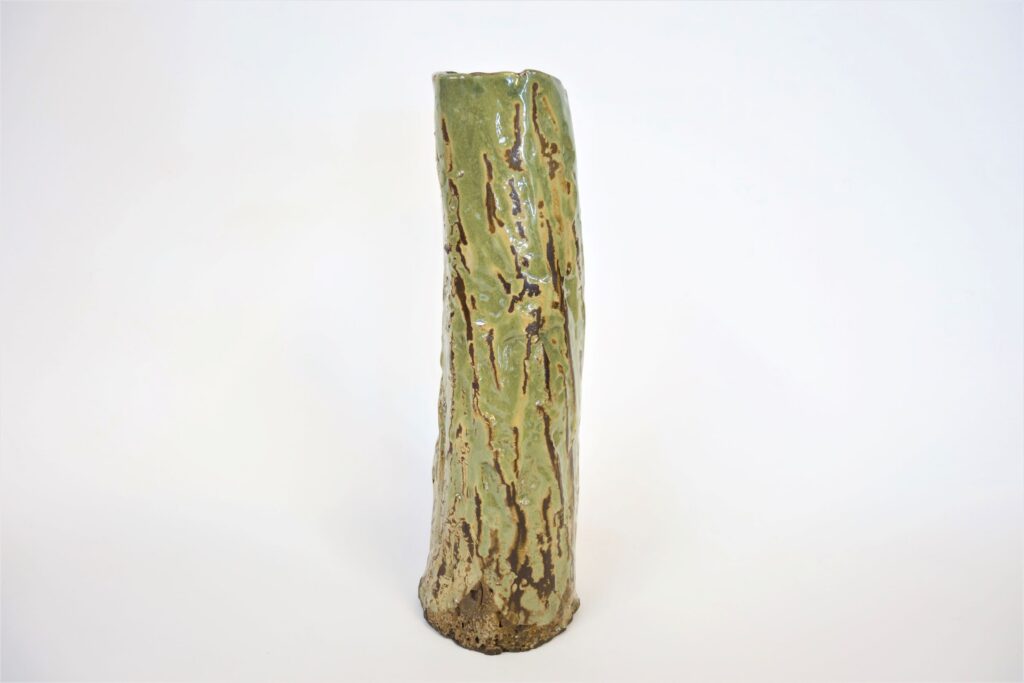
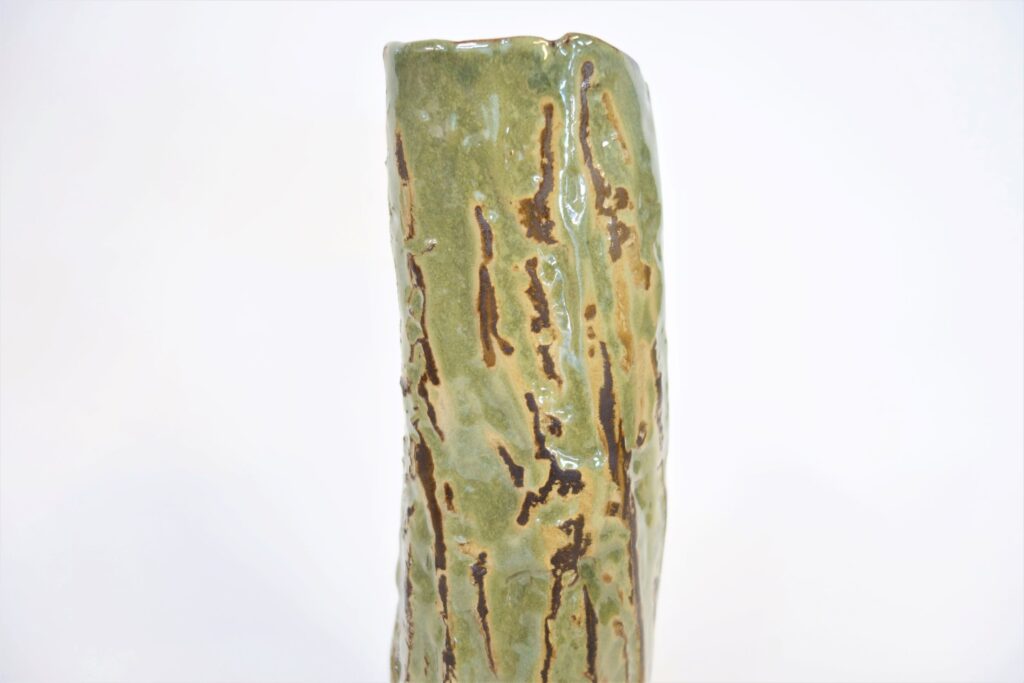
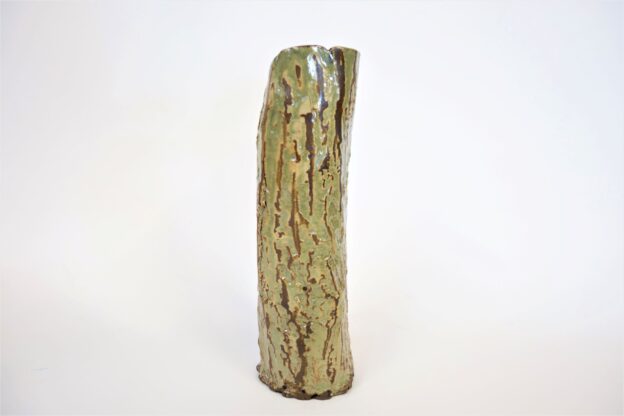
A slab impressed against bark, then twisted into the shape of a tree trunk.
Stoneware, black clay, fired to cone 6, in oxidation.


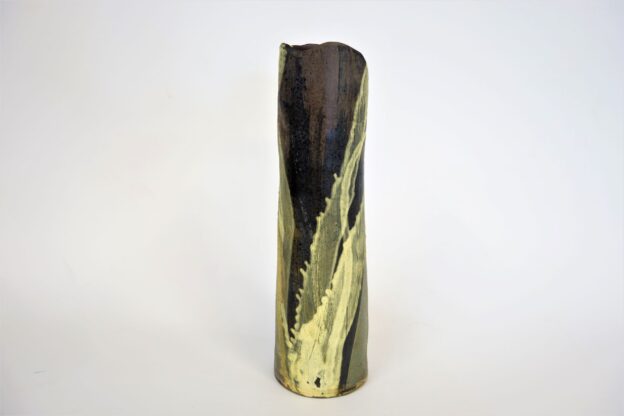
Slab-built, with a dark black clay, finished on the wheel; the rim cut away to firm waves.
To provide a variety of dark black tones, darker than the grey that the black clay would become once fired, I dipped a small, rough sponge in black underglaze, and swept it up the length of the vase, several times. I wanted to create a sense of moving waters, and swirling vegetation in the depths. The first step was pouring a thin layer of a matte, olive-grey glaze, from the top, and down, holding the cylinder at a sharp angle. This glaze, when applied thin over the dark surface, turns ashen, a lovely surface over which to squirt streams of yellow slip, tinged with rutile, sunlight reflecting off the swirling kelp. A few quick strokes of black, high-grit glaze applied with a hard-bristled brush, further break up the surface.
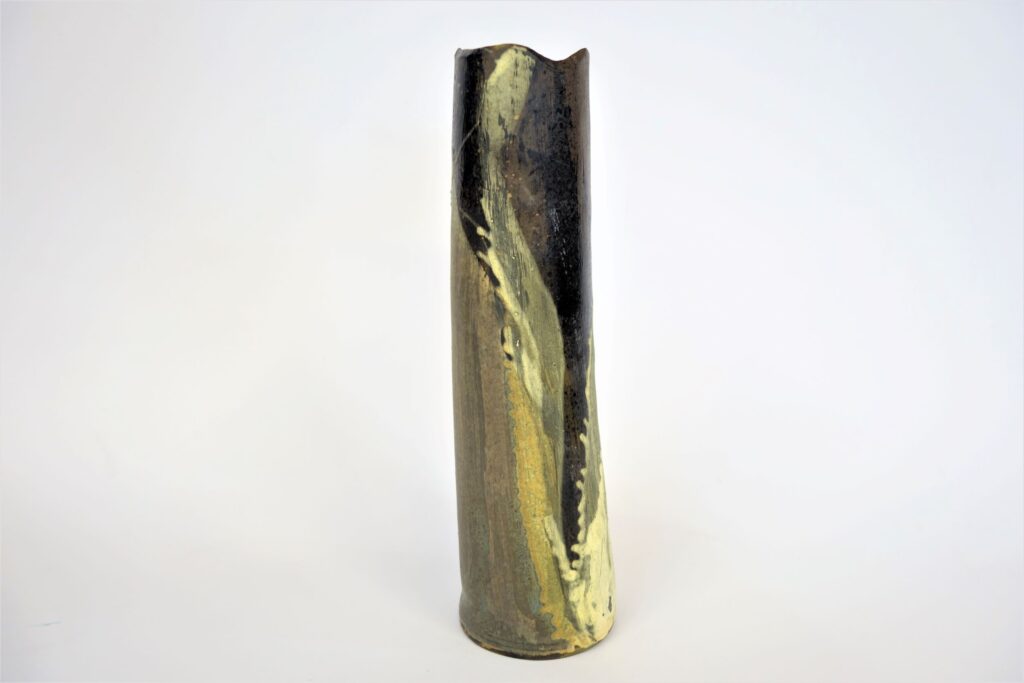
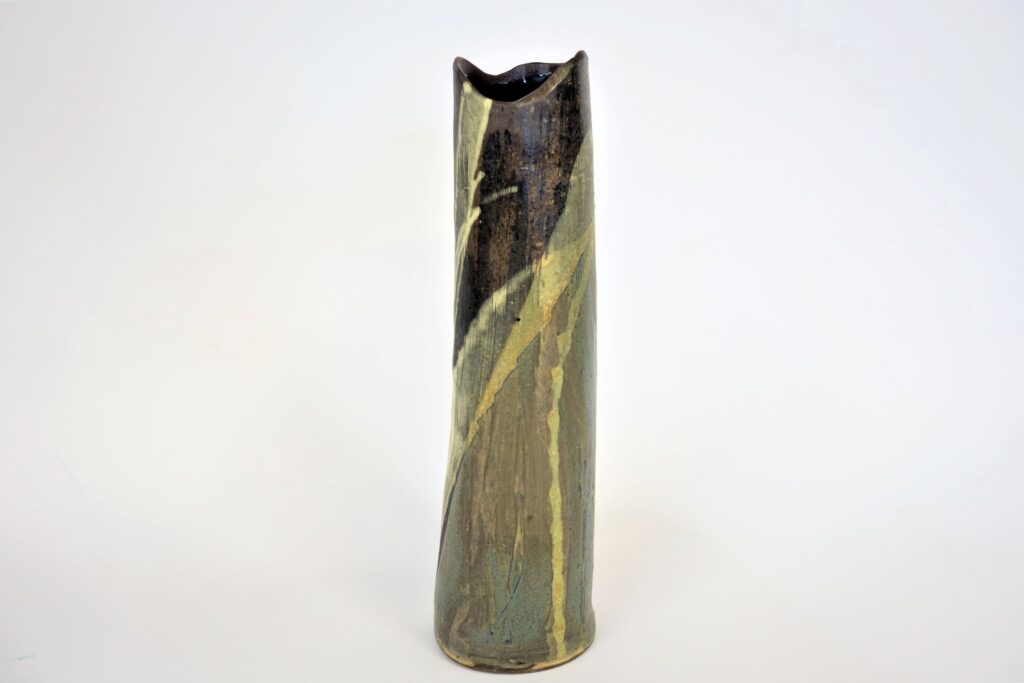
Stoneware, fired to cone 6, in oxidation.
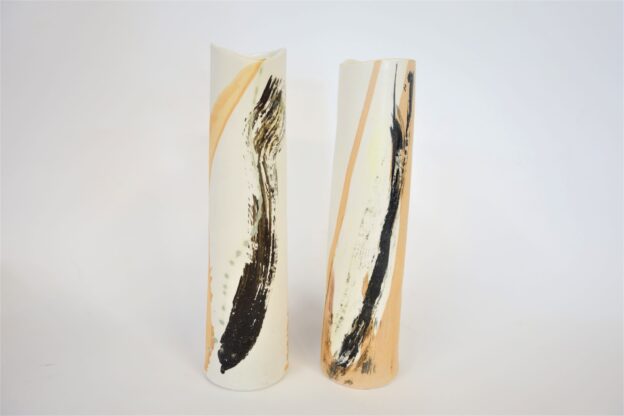
So many possibilities, as I plan my cylinders. Shall I use porcelain, or black clay? Shall I create a highly-textured surface? Shall I forcefully distort the surface? Shall I use slips? Squirt the slips, adding grit, frit, sand, rust? Shall I throw the slip on, pour it on, blow it on? Make it so thick that it cracks in the firing? When, while the slip is still damp? Or wait till tomorrow? Slab built, then finished on the wheel.
For the pieces shown below, I shaped them using slabs of white clay, keeping the neck wide enough for my hand to reach down inside, allowing me to finish them off on the wheel. Did I use porcelain? No. But to enhance its whiteness, I coated the leather-hard piece in a porcelaneous slip (Frost). Did I create a highly-textured surface? No. But using a hard-bristle, broad paint brush, I roughed the surface by adding heavy grit to the dark glaze. Once bisque fired, I applied a few quick free-hand squirts of a yellow/orange slip. Finally, using an atomiser, I applied a fine layer of a glossy, transparent glaze over the remaining white surfaces.
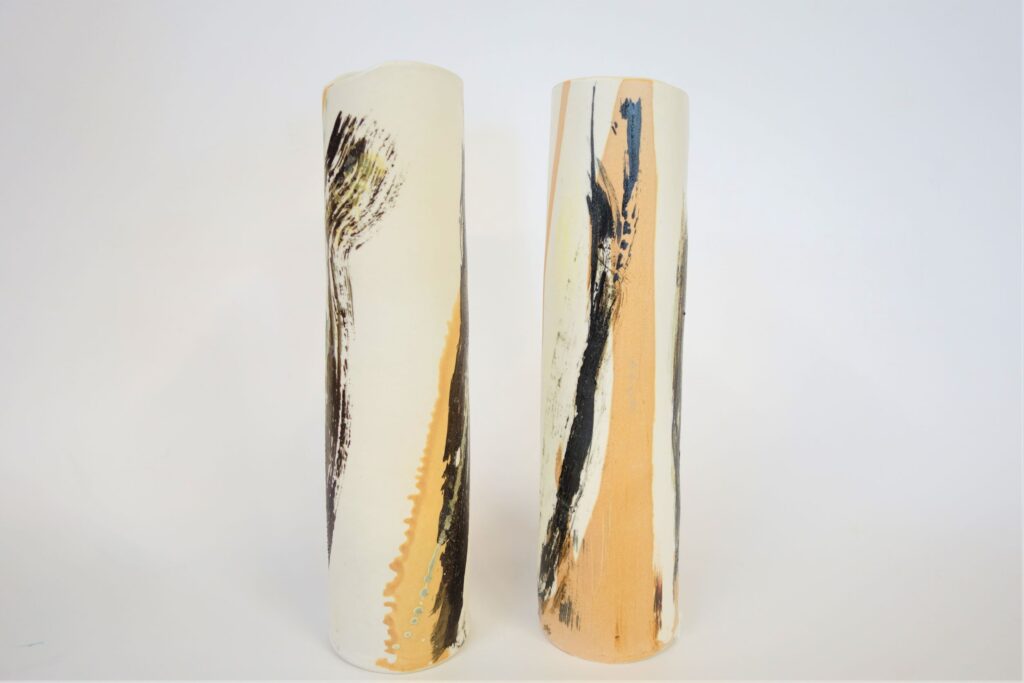

Stoneware, fired to cone 6, in oxidation. Height: 31 cm; Dia. at base: 8.5 cm.
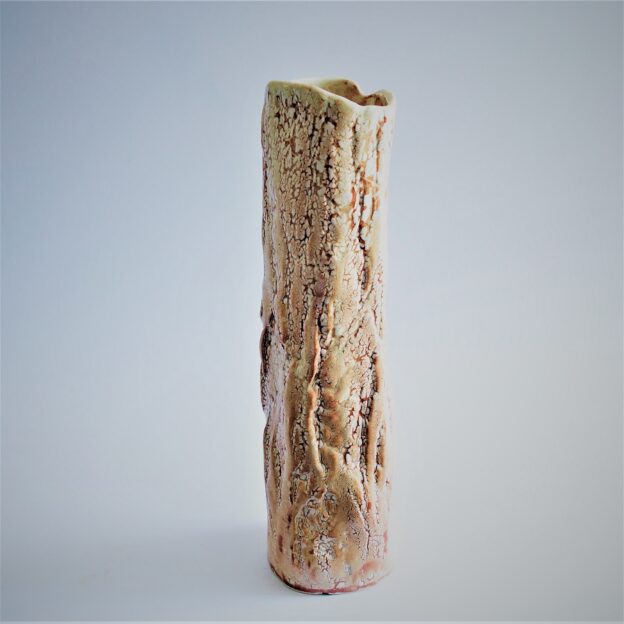
Some of us at ClayWorks have been experimenting with Falls Creek Shino, which works quite nicely in oxidation to cone 6 (depending of course on application thickness, specific gravity, clay used, and all the other parameters that come into play). Initial tests were promising, so I used it on this piece. The result was good, but I hadn’t really thought about this shino actually giving quite a glossy finish, something I didn’t want for these pieces. I hid it away for a while, and wondered.
What about pouring another, more matte glaze over the entire piece, and hope the cylinder survives a second glaze firing? Given the ruggedness of the vessel, I wondered whether a crawl would do the trick.
Whether it still looks like bark, I don’t know. But the satin white glaze has broken up beautifully as it slipped into the crevasses of this shino-glazed cylinder.
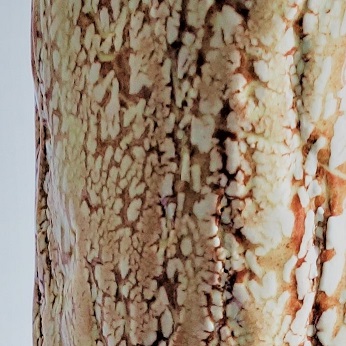
Hand-built, stoneware slab, moulded against bark.
Fired to Cone 6, in oxidation.
Ht: 31 cm; dia. at base: 8 cm
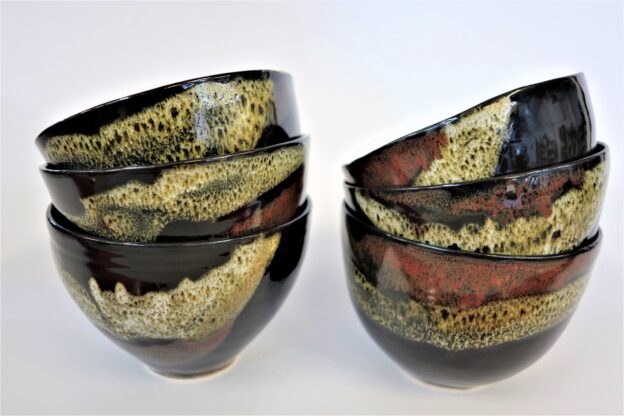
One of my former clients has fallen for this bowl, and wants to choose a few of them, to be given as a gift. I fired a number of them this morning, this time in a slow downfire kiln, which might make the meld between the various overlaid glazes even more interesting. I don’t think there is much risk. They should turn out as good as this one, or, hopefully, even better.
Here, the satin white glaze, squirted with a slip trailer in a thick stream, breaks nicely over the black; and where the squirt lands on two layers of glaze, the iron red (using 18% red iron oxide) over the black, the white turns to a broken light fawn.
With the various lockdowns of the pandemic, it has taken me a while to re-find the smooth gestures that came so naturally before. How far do I hold the slip trailer from the surface to be glazed? How quick do I make the sweep? I also struggled to find the design I wanted, with the smaller touch of colour near the rim on the inside, reflecting the curves of colour on the outside. But I’ve been in the studio, Clayworks, for sometime now, and am finding my way again…
White stoneware, fired to cone 6, in oxidation. Dia: 13 cm; ht: 8 cm
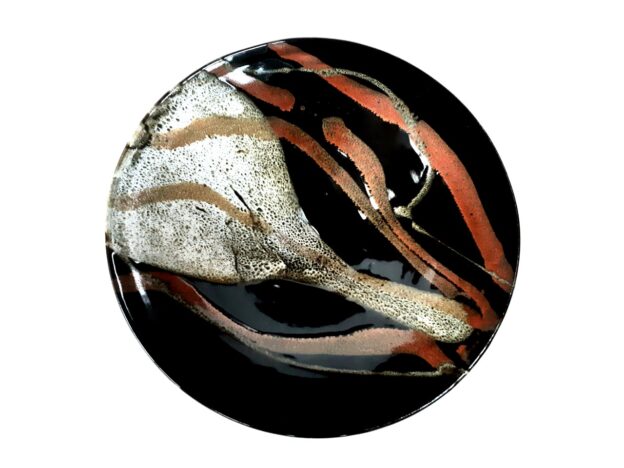
A dark glazed bowl, just waiting for colour. Holding the bowl in one hand, I tip it at a slight angle, hold my breath, and sweep the inner curved surface with a squirt of iron red. I wait, don’t move, then again squirt, using a wider nib, and a contrasting white glaze. Then comes the firing to cone 6, in an electric kiln. How much will the lines run, how mottled will be the effect of the white breaking over the dark underlying glaze? And, always, the big question: how red a red will the kiln be kind enough to give me this time?
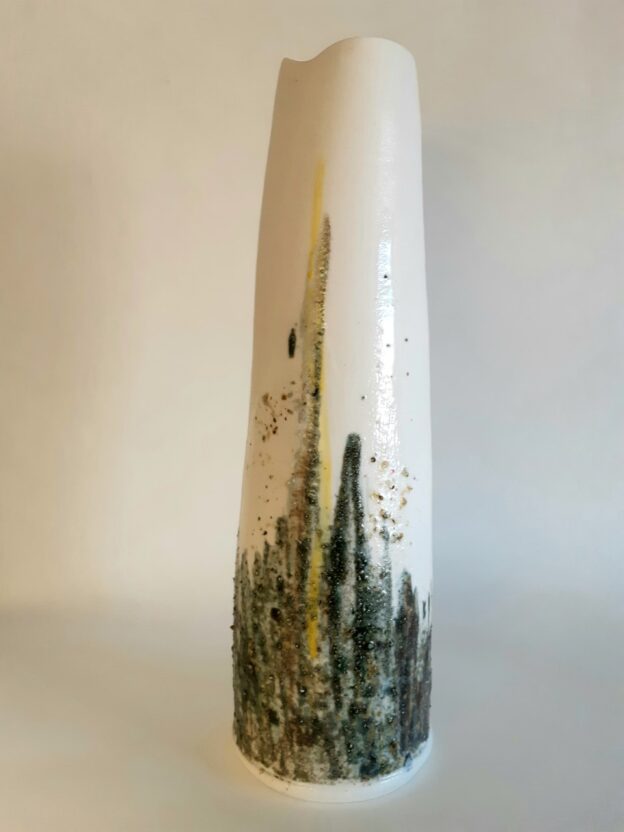
You may think it surprising to see this tree trunk here; after all, it is a hand-thrown cylinder, like the Ghost Gums I made last year. More recently I have been making my barks from my hand-pressed moulds (see Tree trunk, black).
I really liked the grit that I’d pressed into the clay here and there, and I’d thought light touches of colour might complement it nicely. But it needed more work. I left the cylinder to wait for a more inspired moment. It waited quite some time.
The other day I decided enough was enough. I took a matte, black glaze that I knew well. and thought I’d add some local grit. Knowing from previous tests that the grit from around our studio fired nicely, I took a handful and added it to my pot of glaze. Then took my paintbrush and applied it to the base of my old cyclinder.
Being a second firing, this glaze’s colour fired to a very different colour from its usual matte black, giving me much lighter greyish tones. The parking lot grit adhered nicely.
Stoneware, fired in oxidation to cone 6. Height 12″; dia at base 3.7″
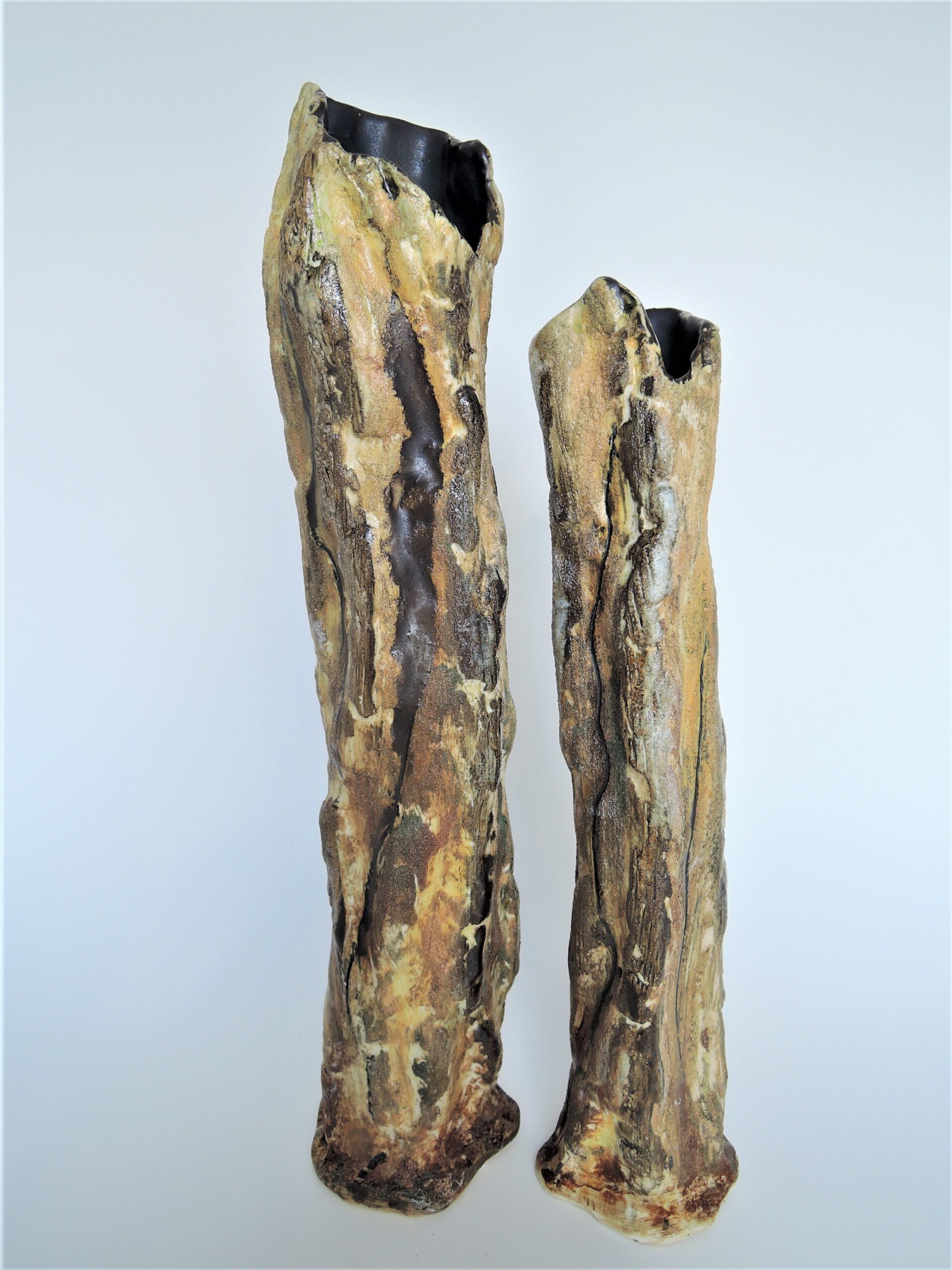
My tree trunks are becoming more varied. Since my earlier blog post Ghost Gums, which were thrown on the wheel, I have more recently been using slabs of clay, impressed on trees, as moulds. I explained the process in my post Tree Trunk, black.
I press, and tear, and force the seams together, and they don’t seem to mind. I used quite a variety of underglazes here, adding sand to the mix, aiming to create an unexpected, slightly rough, bark-like effect.
These two seem to belong together, the one nestling in the lee of the other.
Stoneware. Fired in oxidation, to Cone 6. 1. Ht: 13″, dia: 2.5″; 2. Ht: 11″, dia: 2″
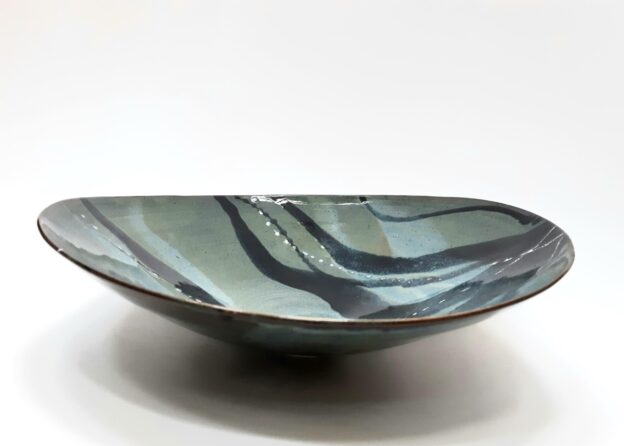
See a flaw, and I must make my peace with it. But when opening a glaze kiln and seeing a piece that yes, hold on, just might be fine, then, risking all, turn it over, and I see that all is well, aah, that feels good.
As I have explained in previous blog posts, the trick with these bowls is to have the piece trimmed and finished, and yet still damp enough to withstand the pressure I put on it, as I force the sides inwards and upwards, to create this distorted, wave effect. I cajole it into doing my bidding, while at the same time I must keep the foot from lifting, keeping it flat to the work table. Some bowls rebel on me and start to crack, others pretend to give in, only to settle back into their original shape as they soften in the heat of the kiln. Then some, like this one, let me have my way.
Stoneware. Fired in oxidation, Cone 6. Distorted. Dia: 13″ – 13.5″; ht: 3″ – 3.5″
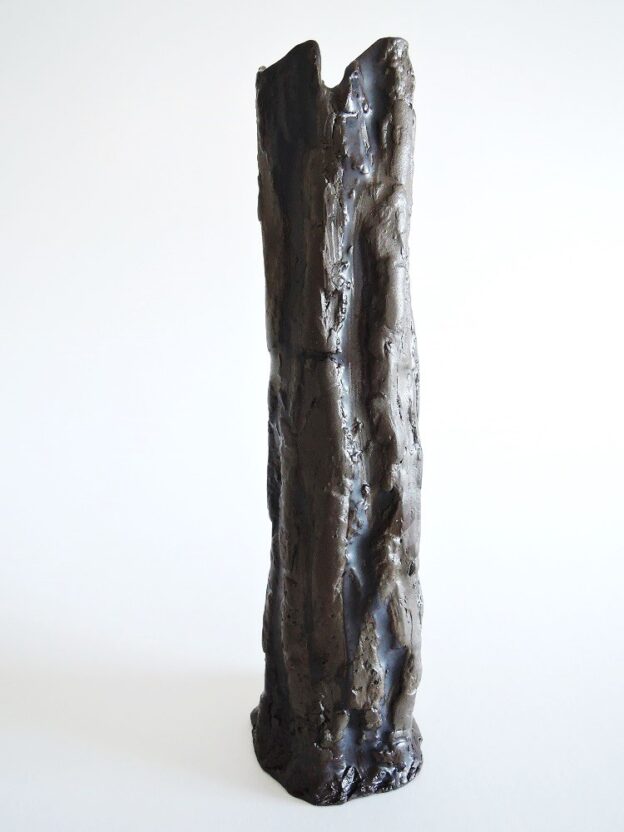
Stoneware; black clay: ht. 30 cm
Fired in oxidation to Cone 6
Here’s the latest in my series on tree trunks. They’ve been changing, radically, over time. The early ones, based on the Ghost Gums I saw in Sydney, were two thrown cylinders, attached, and made with a very white porcelaneous stoneware. Most of the cylinder remained almost pure white, with only the base dark, coated in a high grit, matte, dark glaze. In Cape Town, the variety of trees in the downtown Company Gardens was so astonishing, so huge, that to reflect their variety, I turned to underglazes, which I saw potters using while I was there.
Then at home during the summer, and with the studio closed due to Covid 19, I worked on my balcony rolling out slabs of clay, which I’d take on my walks, and press them against trees, for texture. I then tried to force the slabs into cylinders. I soon realized that to improve them, I really needed a positive impression of the bark. Therefore, when Gladstone Clayworks re-opened, I began bisquing some of these bark impressions, and continuing from there.
This piece came out of the kiln yesterday. I had dipped the entire piece into a matt black glaze, and then sponged most of the glaze off the raised areas. The result provides two tones, enhancing the rough texture of the vessel.
